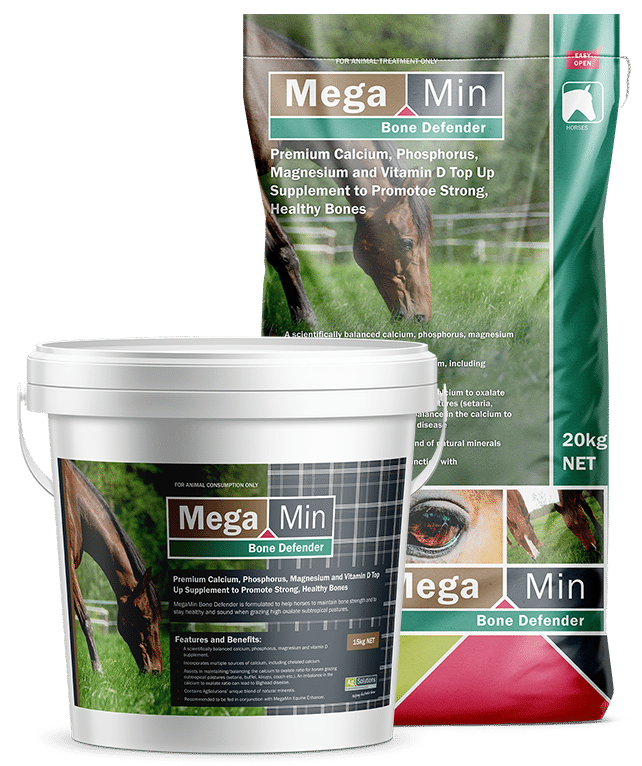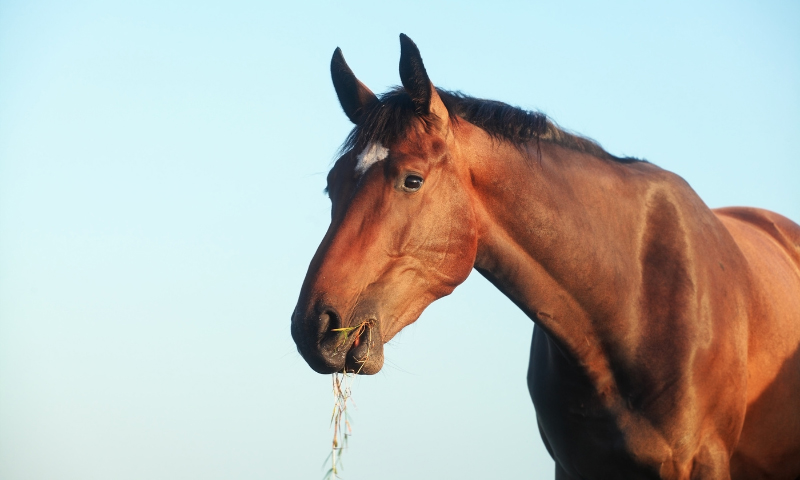What type of grass is your horse eating?
We all know that horses are designed to eat grass and in most cases the greater the percentage that grass contributes to the overall diet, the better it is for the horse’s health. However, if you have horses grazing any of the following sub-tropical grass species, your horse’s ability to absorb calcium can be adversely affected due to the high levels of a compound called oxalate that is found in these species.
Grasses that contain high oxalate levels:

What can happen to your horse if it is eating these grasses?
If horses are left grazing these pastures without any calcium supplementation then they can develop a disease called Nutritional Secondary Hyperparathyroidism that is commonly known as “Bighead”. Bighead is literally a severe and long-term calcium deficiency that can result from the oxalate compound found in the above grasses ‘grabbing’ hold of calcium and blocking it from being absorbed. When the horse isn’t getting enough calcium from its diet it will take the calcium (and phosphorus) from its bones to maintain blood calcium levels. If the calcium deficiency continues the horse will end up mobilizing so much calcium and phosphorus from its bones that they will become brittle and weak.
The higher the amount of oxalate that the grass contains, the quicker a horse can develop bighead. Setaria grasses, in particular Kuzungula Setaria are the most dangerous grasses for horses to graze as they contain the highest levels of oxalate. Horses have been known to develop severe bighead within months of exclusively grazing this grass.
What symptoms could indicate that a horse is suffering from Bighead?
Facial bone swellings that have led to the disease being called ‘Bighead’ are the signs that most people look for, however, this symptom is more frequently seen in younger horses. If you have horses grazing high oxalate sub-tropical pastures it is advised to keep an eye out for any of the following indicators:
- Shifting lameness, sore bones and joints
- Weight loss and harsh coat
- Ligament and tendon injuries
- Changes in behaviour
- Noisy breathing and nasal discharge
- Enlarged/swollen facial bones (ridge over nasal bone)
- Early tiring and a low tolerance for work
- Loose and shifting teeth and difficulty chewing
What should I do if my pasture contains high oxalate grasses?
Luckily for horse owners you can successfully run horses on high oxalate pastures and avoid the development of Bighead disease as long as you provide extra dietary calcium to keep the calcium to oxalate ratio above 0.5 parts calcium to 1 part oxalate. When supplementing horses to prevent the development of Bighead caused by grazing grasses high in oxalate it is important that in addition to calcium, phosphorus is also provided while maintaining a balanced ratio of around 2 parts calcium to 1 part phosphorus. To help provide your horse with every opportunity to absorb supplemented minerals it is advisable for them to be off the affected grass for an hour or so after they have been given their supplement. Also providing a biscuit or two of Lucerne Hay to your horse will have a two-fold effect with the Lucerne being high in calcium and as it’s also a forage source it will mean that your horse will eat less oxalate containing grass.
How can AgSolutions help?

Premium Calcium, Phosphorus, Magnesium and Vitamin D Top-Up Supplement to Promote Strong Healthy Bones
Formulated with broad spectrum macro and trace minerals plus additional calcium, magnesium and phosphorus, MegaMin Bone Defender helps horses maintain bone strength and stay healthy and sound while grazing high-oxalate subtropical pastures. Left unsupplemented on such pastures, horses are at risk of developing severe bone demineralisation or bighead disease.
MegaMin Bone Defender is formulated to provide enough high quality and bioavailable calcium, magnesium (oxalates block magnesium absorption too!) and phosphorus to assist horses to maintain bone strength and to stay healthy and sound when grazing high oxalate subtropical pastures.
MegaMin Bone Defender has been specially formulated in conjunction with a leading Australian Equine Nutritionist to meet the calcium needs of horses with access to diets consisting largely of high oxalate pasture. The supplement has been scientifically balanced and has added vitamin D to help ensure optimum uptake from the digestive system. The amount of supplement required to balance the calcium to oxalate ratio will vary significantly depending on the type of grass being grazed, work level of the horse and other contributing feeds being fed, so in the case of supplementing to help prevent Bighead disease a one dose fits all does not work. To help address the many different feeding situations, the feed guidelines for MegaMin Bone Defender are very detailed and based on scientific research.
Bone Defender is recommended to be used in conjunction with MegaMin Equine Enhancer or as part of a balanced diet to help address trace mineral deficiencies. A trace mineral premix has NOT been added to Bone Defender in order to eliminate the potential of having excessive trace mineral levels in the situation where significant amounts of supplement is required to counteract the negative effect of oxalate in Setaria species.
MegaMin Bone Defender is available to purchase from stores in 15kg buckets. If larger quantities are required, please get your store to contact AgSolutions on 1800 81 57 57 for bulk pricing and expected lead times.
Please contact us to find out how AgSolutions® can help with your equine nutrition inquiries.

Written by AgSolutions® Technical Advisor Shannon Godwin BAppSc GDTL
